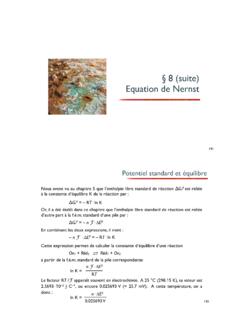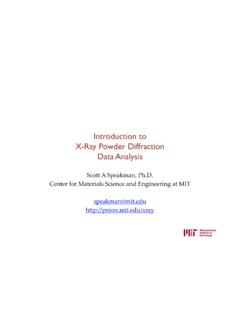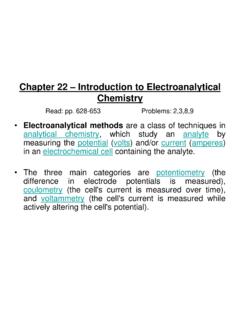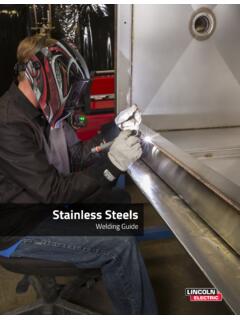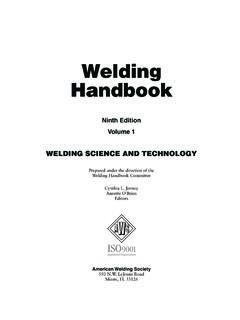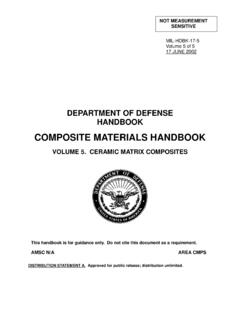Transcription of Ceramics: Sintering and Microstructure
1 Practical classes "Ceramics & Colloids ": TP3 Sintering 1 TP3 - Ceramics: Sintering and Microstructure Responsable: Aslam Kunhi Mohamed (MXD 334, Tel: 36894) 1. introduction After the initial molding of the ceramic , whether by slip casting or dry pressing, it is still necessary to densify the compacted powder samples (green bodies) to form a continuous 3D structure and thus to get ceramic pieces appropriate for the selected application. Usually this is done by a Sintering process which is a consolidation and densification step of the granular compact through the action of heat. During this stage, the Microstructure of the samples evolves (see Figure 1). Figure 1 Sintered Powder and Microstructure . Source Krell et al.[8]. Pores, second phases and grain size have all an important influence on many of the final properties of ceramics. In general, the porosity has a more pronounced effect than a second phase or the grain size, because most of the desired properties ( elasticity or thermal conductivity) are zero or close to zero in the pores.
2 Thus porosity is often detrimental to important properties such as elastic modulus, tensile strength, hardness or the thermal and electrical conductivities. The desired final properties depend on the final application of the sintered piece. For example, for a hip replacement a very high mechanical strength is required, so the residual porosity of the sintered part should be very low. However, for a catalyst, a high specific surface area is usually essential and therefore the porosity after Sintering should be high while still ensuring a good cohesion of the piece. There are three types of Sintering with different densification mechanisms: 1. Solid phase Sintering : all components remain solid throughout the Sintering . The densification is carried out by a change in shape of the grains. Mass transport occurs by volume and grain boundary diffusion. 2. Liquid phase Sintering : formation of a viscous liquid (usually a eutectic with a low melting point) that fills the pore spaces of the initial green body ( porcelain).
3 Densification occurs mainly by dissolution and re-precipitation of the solid which allows a rapid mass transport. 3. Reactive Sintering : two or more constituents react during Sintering . The densification is carried out by the formation of a new compound. From a technical perspective, the densification during Sintering can be improved by applying an external force. The most common techniques are the application of a uni-axial pressure (HP = hot pressing) or isostatic pressing (HIP = hot isostatic pressing). Additionally, there is a variety of Practical classes "Ceramics & Colloids ": TP3 Sintering 2 techniques to influence the microstructural characteristics of the final piece by changing the heating and cooling rates. An example is spark plasma Sintering (SPS) where very high heating and cooling rates are achieved with the help of a pulsed electric field which leads to a high density in a relatively short period of time (5-10 minutes) while keeping a relatively small grain size.
4 [12] The subject of this lab is about natural, solid phase Sintering ( heating in a conventional oven without applying an external force). Various factors influencing Sintering will be discussed. The objective is to understand the driving force and the mechanisms of Sintering and to get an idea of how they can be influenced. The influence of the particle size and of the addition of dopants on Sintering will be studied. As the experimental methods can only provide limited information on the topics we will use digital modeling techniques to better understand what happens during Sintering . To follow the progress of Sintering we use a dilatometer which tracks dimensional changes in a piece during Sintering . The density and residual porosity of the final piece is then studied with an experimental method called the immersion or Archimedes method. 2. Density and Porosity Measurements Density and Porosity - Definition As mentioned previously the porosity has a huge impact on the final properties of a sintered ceramics.
5 However, the total volume of the porosity is insufficient to understand the Sintering behavior and the final properties of the material. There are several additional characteristics that will influence the porosity: 1. The connectivity of the pores: there exists open and closed porosity. In the first case, the pores communicate with the outside of the material, they can theoretically be filled with a fluid by immersion of the piece. In the case of closed porosity the pores are isolated inside the material. 2. The pore size: the pore size is important for the final properties as well as during the Sintering as small pores are much more difficult to eliminate than large ones. 3. The shape of pores: the pores can have different shapes which influence their behavior. Open pores are typically thin, elongated and irregularly shaped. The closed pores are typically more equiaxed. 4. The distribution of the porosity: the global special distribution of the porosity can be of importance.
6 For example during the production of ceramic layers, the porosity is not always uniform throughout the thickness of the layer. The evolution of fractions of open and closed porosity versus the fraction of theoretical density is shown in Figure 2a) for different spinels (SiC and SiB4). This shows the replacement of the open porosity by closed porosity. On a fracture surface (Figure 2b)) we can see different types of pores for Al2O3: flat (1-4), elongated (4 and 7) and of more complex shape (5-6). If one maximizes the porosity for a given application, one can obtain a foam (Figure 2c)). Such foams are typically used for filtration or as a catalyst because of their high surface area. Practical classes "Ceramics & Colloids ": TP3 Sintering 3 (a) (b) (c) Figure 2 Illustration of porosity: (a) evolution of open and closed porosity. (b) different shapes of pores. (c) ceramic foam with high porosity.
7 Immersion Method / Archimedes Method The absolute densities calculated from crystalline structures or measured using pycnometry [6] as well as the dry, wet and immersed masses can be used for the calculation of apparent densities and the volume fractions of the open and the closed porosity. The solvent used during this TP is deionized water without additive. However the same procedure can also be done with alcohol or other solvents wetting the material studied. In the case of alcohol, solvent evaporation can greatly affect the quality of measurements due to evaporation and the time between the different stages of measures must be strictly controlled. In general one can distinguish between two different types of porosities: Open porosity, po: pores that communicate with the outside of the material, they can theoretically be filled with a fluid. Closed porosity, pf: the pores are isolated inside the material This means that the apparent volume Vapp is equal to the sum of different parts of the sample: The actual volume of the solid Vs, the volume of the open porosity, Vpo and the volume of the closed porosity Vpf (see equation (1)).
8 AppspopfVVVV (1) If we assume that the solvent wets the entire surface of the open porosity, the open porosity can be estimated from the impregnated (m2) compared to the dry mass (m1) divided by the water density eau (equation (2)). 21poeaummV (2) The volume of the closed porosity can be determined via the buoyancy PA or the immersed mass m3 (equation (3)): We consider that this force is exerted on the volume of the solid (Vs) with a material dependent density abs ( 3987 g/cm3 for alpha alumina) and on the closed pore volume (Vf) with essentially zero density (equation (4)). This means that the volume of the closed pores can be calculated according to equation (5). Practical classes "Ceramics & Colloids ": TP3 Sintering 4 3 APm (3) AspfeauPVV (4) 31 ApfseaueauabsmPmVV (5) The percentage of open pore volume (Po) and closed (Pf) can be calculated as follows: Po VpoVapp 100 Pf VpfVapp 100 And finally the effective density of the sample 2 (closed pores included.)
9 Is: 1112eauAspfAeaummmPVVP Samples The ceramic studied is alumina (chemical formula Al2O3) with and without dopants. We will measure a series of three sintered pellets (natural Sintering in air) at three different temperatures will be used: 1400 C, 1500 C and 1700 C (ramp 10 C / min). Operation mode The liquid used for immersion must be stable and controlled. Water must be at a constant temperature to avoid variations in density, this is why the water used for soaking the samples (cooler than the ambient temperature) should not be used. Number the pellets using a felt pen (water resistant). 2. Set the balance to zero (tare) with the immersion basket in water. Weigh the dry samples (dry mass, m1) 3. Place the samples in a small beaker and create a void 4. At the same time put enough water into the beaker to immerse the samples completely 5. Keep the void until no more air bubbles are observed (~ 30 min) 6. Take the samples out of the water and dry them carefully then weigh them (impregnated mass m2).
10 When working with alcohol, isopropanol this last step must always be done in the same time within 30 seconds. 7. Tare the balance and then weigh the sample in water (immersed mass, m3) (can be repeated 2 or 3 times to check reproducibility). Measure the temperature of the water for each sample. 8. Calculate the apparent density, the relative density and the effective, open and closed porosity according to the equations above. Use the value of the density of water from the table given in the annex. Practical classes "Ceramics & Colloids ": TP3 Sintering 5 3. Sintering Driving force of the Sintering The driving force for Sintering is the reduction of the interfacial free energy of the system, both by replacing the solid-gas interfaces (surfaces) by grain boundaries (densification), and by reducing the ratio of the interfacial area per volume of the grains (grain growth). Thus there are always at least two phenomena that compete during Sintering : densification and grain growth.


